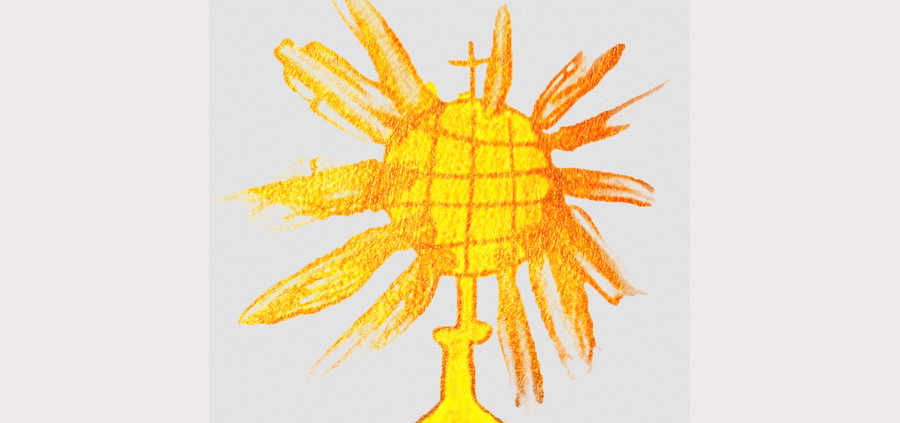A Dance, a Drama, and an Action by William Droel
I would like to offer some suggestions for improving a Catholic’s appreciation for the real presence of Christ in the Eucharist.
Number one. Instead of the usual binary choice (symbol or real presence), let the next survey include a third option like: “The Eucharist is both really Christ and a symbol of a convivial dinner, of an intimate relationship, of self-sacrifice, of collective action as well as a preview of heaven.” Let’s see what such a survey reveals.
Polar positions on the Eucharist gradually emerged in Christianity. In reaction to Gnostic heresy, some people developed an extreme position about Jesus’s physical presence, such that if the Eucharistic host fell to the floor, Jesus would suffer a concussion. To tone matters down, Deacon Berengar of Tours (999–1088) came along to say the Eucharist is a symbol, with Jesus spiritually present in the bread and wine. He was excommunicated and imprisoned for tipping the belief too far in the other direction. St. Thomas Aquinas (1225–1274) then restored the proper balance between physical presence and the Eucharist’s symbols—only to have the Counter-Reformation (about 1545–1648) place greater emphasis on how the bread and wine become Our Lord. This emphasis sometimes came at the expense of the Eucharist’s meaning.
Which brings us to number two. Don’t necessarily equate transubstantiation with real presence. Isadora Duncan was once asked to interpret one of her modern dance routines. “I can’t explain the dance to you,” she replied. “If I could tell you, there would be no point in dancing it.” Transubstantiation is a plausible explanation for how God becomes present in what looks like bread and wine. It is, however, based on Hellenistic distinctions that are lost on nearly all young adults. Does Catholicism want to insist that young adults be schooled in metaphysics before they can believe in the Eucharist?
In the 14th century, Fr. William of Occam, OFM rejected Platonist duality. There are not two worlds, he said; the objects in front of us are not merely archetypes of the forms, the universals, the really real. Church officials took his materialist philosophy as an attack on the substance/appearance distinction that supports transubstantiation. These officials subjected William of Occam to disciplinary charges.
The real presence in the Eucharist is a dogma. But it is just as important to Catholicism to remember that the Eucharist is a dance, a drama, and an action.
Number three. Catholic preachers can make positive points about Catholic belief without making comparisons to other denominations. When they bring the beliefs of other Christians into a homily, Catholic priests and deacons often get things wrong. Is Orthodox Christian belief in the Eucharist different from or the same as Catholicism? Our Catholic preacher doesn’t say. Is the Episcopal belief the same as all mainline Protestant beliefs? What about the evangelical belief, or the Evangelical Lutheran Church in America and other Lutheran Synods? Is Catholicism on one side and all other denominations entirely on another? All this is a matter for the classroom, not the pulpit. Further, such comparisons are counterproductive because many Catholic worshipers have a Protestant spouse, daughter-in-law, close friend and the like.
Number four. Bring back an understanding of the Mystical Body of Christ, a concept that first appeared in the 12th century and was popular in the first half of the 20th. It fell out of favor by the 1970s, replaced by concepts like “the people of God” and “a pilgrim people.” The Mystical Body of Christ is not one more metaphor; it is an organic reality. It means that Jesus is really present in the people we meet throughout our day. Put it this way: If a Catholic does not see Christ in their coworkers, in neighbors, in the lonely, the homeless and the refugees, then that Catholic can hardly see Christ in the elements of bread and wine. The Mystical Body of Christ is all the people on the subway, in the hospital, at the office, in the restaurant and at home.
Eucharistic ministers (both ordinary ministers and extraordinary ministers) can make one gesture to convey the mystery of the Mystical Body. They can stick to the script. Their line is: “Body of Christ” (if they are holding the paten) or “Blood of Christ” (if they are holding the chalice). No need to ad lib, as in “Receive the body of Christ and be whole” or “This is the body of Christ.” The script is intended to be vague or, if you will, inclusive. The idea is that Christ is really present in the Eucharistic elements but also in the person receiving communion. Christ is really present in the priest (i.e., alter Christus) during Mass. Christ is really present in the proclamation of God’s Word by well-prepared lectors. Christ is really present in the entire congregation dismissed as one to go into the world; to be alert to Jesus hungry, Jesus in prison, Jesus thirsty, lost, neglected, struggling, growing, laughing, learning, and rising. The transformation of the bread and wine is the transformation that has been accomplished in humankind because of God’s gift of Incarnation.
William Droel is the editor of Initiatives, a printed newsletter on faith and work, and the author of Monday Eucharist, available from the National Center for the Laity (PO Box 291102, Chicago, IL 60629; $7).





Leave a Reply
Want to join the discussion?Feel free to contribute!